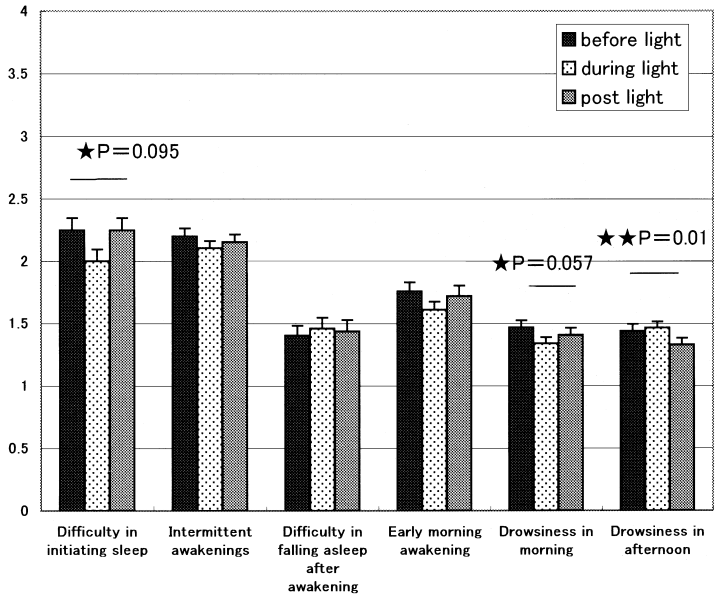Effects of bright light at lunchtime on sleep of patients in a geriatric hospital I
Abstract
The effects of lunchtime bright light exposure in patients of a geriatric hospital were investigated. Ten inpatients (six women and four men; mean age ± SD: 81.2 ± 8.8 years) with sleep disturbances were studied for 9 weeks. Nurses performed daily ratings for sleep–wakefulness disturbances. Approximately 8000 lx bright light exposure was performed for 3 weeks in the light therapy room. Before and after exposure, ocular function was evaluated. Clinical ratings of sleep-wakefulness improved in eight patients. The score of difficulty in falling asleep and drowsiness in the morning declined during the light exposure. The score of drowsiness in the afternoon decreased during the post-light exposure. Post-exposure ocular disturbances were not found.
INTRODUCTION
A previous study has confirmed that sleep in the nursing home environment is extremely disturbed and that patients sleep more frequently during the day.1 Bright light treatment improved sleep–wake rhythms of demented patients in a geriatric hospital.2–4 The aim of the present study is to examine the effects of lunchtime bright light exposure on sleep–wakefulness patterns of patients with sleep disturbances in a geriatric hospital.
SUBJECTS AND METHODS
Ten inpatients (six women and four men; mean age ± SD: 81.2 ± 8.8 years) in a geriatric hospital were studied for 9 weeks. They had been hospitalized for more than 5 months. Written informed consent was obtained from the relatives. All patients showed various sleep disturbances. Two subjects were non-demented, and six were moderately to severely demented. All patients had mild to moderate cataracts. Four patients had prescriptions of neuroleptics or benzodiazepine medication.
Nurses performed daily ratings each shift (day and night) for sleep–wakefulness disturbances according to the modified MY (Matsubara Yamaguch) radar chart.5 The rating scale is made up of eight items. In the present study, we evaluated six items: (i) difficulty in falling asleep; (ii) frequency of waking from sleep at night; (iii) difficulty in falling asleep after waking; (iv) early morning awakening; (v) drowsiness in the morning; and (vi) drowsiness in the afternoon. Four of the six items (1–4) were scored from grade 1 (no disturbance) to 4 (severe disturbance). Scores of daytime drowsiness were on a 1–3 scale (1 = none or minimal, 2 = moderate, 3 = severe).
Light exposure was performed for 3 weeks in the light therapy room where fluorescent lamps were fitted on the walls. The exposure time was 1 h at their lunchtime (11:30–12:30 h) under the support by their nursing staffs. The illuminant was approximately 8000 lx at eye position. For each 3-week period, before and after light exposure, patients took lunch under the sham exposure (< 1000 lx). Before and after exposure, best-corrected visual acuity (uncorrected, corrected), intraocular pressure, papillary reaction, ocular position, eye movement, slit lamp examination, ocular funds examination and an amsler grid were examined in order to detect disorders and abnormal changes.
RESULTS
Clinical ratings of sleep–wakefulness improved with light exposure or after-light exposure in eight patients. Figure 1 represents the mean score of all of the patients. The mean rank score of difficulty in falling asleep and drowsiness in the morning declined during the light exposure. The score of drowsiness in the afternoon significantly decreased during the after-light exposure. Post-exposure ocular disorders were not found.

Changes in clinical ratings of sleep–wakefulness.
DISCUSSION
The present study showed that lunchtime bright light exposure administered for 3 weeks to patients with and without dementia in a geriatric hospital ameliorated their nocturnal sleep and daytime wakefulness. Previous reports suggested that bright light therapy was effective in patients with dementia.3–5 The findings of the present study suggest that lunchtime bright light therapy may improve sleep–wakefulness patterns.
Fukuda et al. reported that there was no ophthalmological abnormality induced by 6000 lx bright light for 30 min for 1 week and suggested that further follow-up research was required.6 The result of the present study confirmed that 8000 lx bright light for 1 h for 3 weeks did not induce ocular disorders.
ACKNOWLEDGMENTS
This study would not have been possible without the help and cooperation of doctors and nursing staffs of Hokujukai Hospital (Sapporo, Japan), and without the help of Kazuyoshi Watanabe. The present study was supported in part by a Grant-in-Aid for Scientific Research (C).




